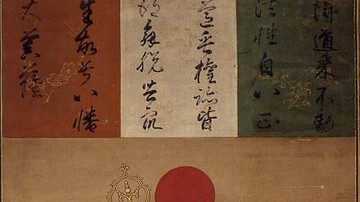
In the Shinto religion kami is an all-embracing term which signifies gods, spirits, deified mortals, ancestors, natural phenomena, and supernatural powers. All of these kami can influence people's everyday lives and so they are worshipped, given offerings, solicited for aid and, in some cases, appealed to for their skills in divination. Kami are attracted by purity - both physical and spiritual - and repelled by the lack of it, including disharmony. Kami are particularly associated with nature and may be present at sites such as mountains, waterfalls, trees, and unusually shaped rocks. For this reason, there are said to be 8 million kami, a number referred to as yaoyorozu-no-kamigami. Many kami are known nationally, but a great many more belong only to small rural communities, and each family has its own ancestral kami.
The reverence for spirits thought to reside in places of great natural beauty, meteorological phenomena, and certain animals goes back to at least the 1st millennium BCE in ancient Japan. Add to these the group of Shinto gods, heroes, and family ancestors, as wells as bodhisattvas assimilated from Buddhism, and one has an almost limitless number of kami. Common to all kami are their four mitama (spirits or natures) one of which may predominate depending on circumstances: aramitama (wild or rough), nigimitama (gentle, life-supporting), kushimatama (wonderous), and sakimitama (nurturing). This division emphasises that kami can be capable of both good and bad. Despite their great number, kami can be classified into various categories. There are different approaches to categorization, some scholars use the function of the kami, others their nature (water, fire, field, etc.). For simplicity, and as those methods mentioned tend to create a lot of overlap, we will here adopt historian M. Ashkenazi's approach.
Classical Kami
Here the 'classical' kami are those which appear in the oldest Shinto texts including the Kojiki and Nihon Shoki. Here we have the gods, supreme amongst them being Amaterasu, the sun goddess. Others include her brother Susanoo, the wind and sea god, Takamimusubi, Okuninushi, and the creator gods Izanami and Izanagi. The first gods who remained in the heavens are often referred to as amatsukami (heavenly kami) while those next generation gods who ruled first on earth are called kunitsukami (earthly kami). All of the kami occasionally, in times of great crisis, assemble for conference on the dry riverbed of the Heavenly River. Many important rivers, mountains, caves, and rocks have their own kami too. In this group are also two kami from across the sea: Sukunabikona and Sarutahiko.
Later Kami
The second group of kami is those which were officially recognised after the early texts had already been composed, which is not to say they were not worshipped earlier. Here we have Hachiman, the deified Emperor Ojin (r. 270-310 CE) who is a god of war and culture, and the rice and commerce god Inari. The reigning Japanese emperor was also considered a living kami. Phenomena such as the sunshine, rain, and wind can be a kami, most famously the kamikaze or divine wind which blew against the invading Mongol fleet in the 13th century CE. There are also individuals deified after death - several other former emperors, the scholar Sugawara Michizane, aka Tenman Tenjin, and Tokugawa Ieyasu, founder of the Tokugawa shogunal dynasty (1603-1868 CE). Foreign gods were also accepted as kami, notable amongst these are the Hindu gods Brahma and Indra, and the Buddhist bodhisattva Kannon. Finally, there are the Seven Lucky Gods or Shichifukujin - Benten, Bishamon, Daikoku, Ebisu, Fukurokuju, Hotei, and Jurojin. They are a mixed group of Chinese, Hindu, Buddhist, and Japanese gods and they are a fine example of how Shinto has welcomed, absorbed, and transformed foreign deities into their huge pantheon of kami.
Local Kami
The third group is local kami, although several of these are generic types recognised as powerful throughout Japan. There are the dragon kami (Ryujin), the kami of crossroads and boundaries (Dosojin), kami of prominent local natural features, kami of villages and individual families. Sometimes animals, especially white ones, are given a kami. Local kami typically appear in pairs, one male and one female.
Worshipping Kami
Kami are appealed to, nourished, and appeased in order to ensure their influence is, and remains, positive. Offerings of rice wine, food, flowers and prayers can all help achieve this goal. Festivals, rituals, dancing and music do likewise. Shrines from simple affairs to huge sacred complexes are built in their honour. Annually, the image or object (goshintai) thought to be the physical manifestation of the kami on earth is transported around the local community to purify it and ensure its future well-being. Finally, those kami thought to be embodied by a great natural feature, Mt. Fuji being the prime example, are visited by worshippers in an act of pilgrimage.
This content was made possible with generous support from the Great Britain Sasakawa Foundation.






